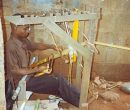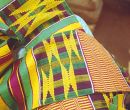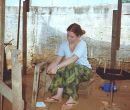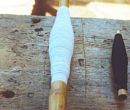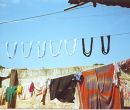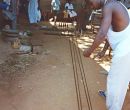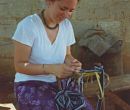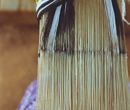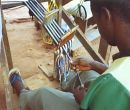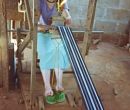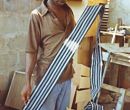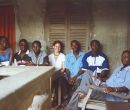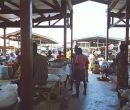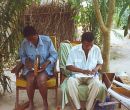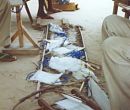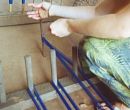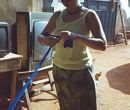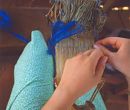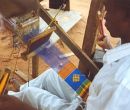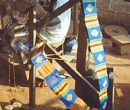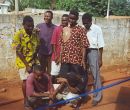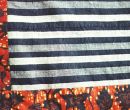Report on a trip to Ghana to learn traditional weaving techniques
Our thanks to Emilia Bess Karr for submitting this article she wrote about her experiences on a trip to Ghana she made in 1998 to learn traditional Kente weaving techniques. All text and photographs are copyright Emilia Karr. For permission to reproduce any part of this article please e-mail the author at lolag24@hotmail.com
The art of textiles is a seductive genre. It is tactile and utilitarian, beautiful and essential. Kente cloth is exceptional in this field of art with a long history in West Africa. Kente is traditionally the textile of royalty in Ghana. Woven in strips, and then sewn together, it is a finely made cloth that can be a solid color or have intricate designs.
My goal in traveling to Ghana was to learn a traditional skill in my field of interest: fibers. I was fortunate to live with a host family supportive of my interest in learning to weave Kente, a traditionally male art form. Within two weeks of settling in my new home of Swanlake, a suburb outside of Accra, my host mother, Auntie Mary, had arranged an apprenticeship for me with a family friend.
Seth is an Ewe man in his mid-late twenties. He never told me of his initial reaction to Auntie Mary's request at teaching me to weave, but it was not too long before he was used to seeing an obroni (slang for "white man") spinning the bobbin or sitting behind his brother's loom.
A brief background on the Ashanti and Ewe
The Ashanti have had a very prosperous kingdom throughout history. Living on land rich in resources and having established a precedence for a warrior army, the Ashanti were able to conquer surrounding groups of people and have a free reign of the area. Trade with Europeans was an important factor for increased wealth and access to such things as silks. Before long, though, slavery became the primary source of trade over any mineral resource that was initially attractive about the area. Soon the musket was introduced to the area and increased instability arose between all of the African kingdoms. During the 17th century, the Ashanti prevailed and were able to establish the empire that still survives today.There is not a singular identity for Kente. Controversy surrounds the origins of this cloth, both Ashanti and Ewe claiming to have invented Kente.
The Origins of Kente
One evening on the front porch, Auntie Mary explained to me how Kente came to be: There was a hunter who was very hungry. He went out to find an animal when he saw a spider. Do you know what a spider is? Eh-heh. This hunter, he watched the spider spin her web . Have you ever seen a spider do this? Mmm. He watched for so long that he forgot about hunting. He went home and learned how to weave from watching the spider.Before Kente was invented, people wore clothing made from the bark of the kyen-kyen (pronounced "chin-chin") tree. This bark was pulled off the tree in large pieces and then pounded till it was malleable enough to sew into clothing.
Another origin story involves a man named Ota Kraban. According to the Ashantis, he brought the first loom from Cote d'Ivoire and went straight to Bonwire, a town outside of Kumasi, and set it up on a Friday. This led to the naming of the loom, Odomankoma nsa dua Kofi, "Kofi, the Creator's Loom." (Kofi is the name for a boy born on a Friday.) This is why traditionally no weaving could either be started or finished on a Friday, in honor of the day that the first loom was set up.
In the early 20th century a man named R.S. Rattray was in Ghana doing seminal work. From his work there, he published a book, Religion and Art in Ashanti (1927), that contributed an idea about the origins of the Kente tradition. He does not question whether the art started with the Ashanti or Ewe, it is a matter of who within the Ashanti introduced it to the region. He is almost certain, however, that the weaving was introduced from the north, as opposed to the south and the European sea routes.
Weaving lessons
Traditionally it takes many months, sometimes a year before a weaving apprentice ever sits in a loom. Patience and observation are the number one virtues in weaving. Seth informed me that the first week of my six-week apprenticeship would be spent observing. We agreed that I would work with him four days of the week starting at eight in the morning and working till four in the afternoon.The first morning of my apprenticeship I was escorted to Seth's family compound by my host sister, Bertha. A fifteen minute walk through the bustle of Swanlake over the uneven roads of red earth found us at the front gate. Children were everywhere as well as many adults. Seth was nowhere to be seen and we were told to go find him in his room. He was still getting ready for the morning and said that Bertha should take me to his brother Gilbert's loom to watch him weave for awhile. We followed the path between the house and the compound wall until we came to a small lean-to with a loom underneath. In this shade Gilbert sat weaving the cloth of royalty. Red, green, golden yellow, black and bits of white. A complicated pattern of stripes and designs of the golden Ashanti stool were being woven.It was another hour or two before I saw Seth again. From Gilbert's loom we continued on the path around to the front of the house again where Seth's weaving area was maintained. He was working on a large order of green and yellow "mufflers," a single strip of Kente worn around the neck, for an organization in the United States. The rest of the day consisted of watching him weave a more simple pattern of wide stripes and stools.
My second day of weaving was a little more strenuous than the first. Seth began with me watching him weave more green and yellow mufflers, and then we moved on to spinning bobbins a few hours later. Most yarn that is used for Kente weaving is bought by the hank. If the yarn is cotton, it needs to be scrubbed with starch to make it "hard," and then allowed to dry before spinning it onto bobbins. Rayon has a consistency that enables the weaver to skip the starching process and go directly to spinning. Cotton and rayon are the most commonly used yarns, and the only two that I worked with. Silk is used as well, but because it is so expensive, it is not affordable to many.
Spinning a bobbin looks relatively easy: cranking the handle of the machine that unravels the hank, and guiding the yarn with the other hand onto the bamboo bobbin. In and of itself, spinning a bobbin is not difficult, but keeping the yarn taut, guiding it evenly and doing this in a speedy manner takes skill. Many students of a traditional apprenticeship will take months to perfect spinning bobbins. Master weavers do not always spin their own bobbins; this is where apprentices are handy. It is vital, though, that every weaver knows the process of preparing to weave. Seth reiterated almost daily the importance of knowing every aspect of weaving: the actual act of weaving is relatively simple, but what makes a successful weaver is the individual who is skillful and knowledgeable about the entire process.Large and small bobbins are used. The large ones are for the layout of the warp, the yarn that is woven onto (vertical), and the small ones are the for the weft, the yarn that is woven (horizontal). Seth had me practice spinning bobbins, small and large, for the next day and a half for his next project. Later on this same day Seth sent one of his brothers out to buy the cotton yarn for my first project: five hanks each of black and white. Once he returned, we scrubbed the yarn with starch and hung it up to dry for the rest of the afternoon.
Laying out the yarn is the next step in the process. This stage involves the use of two rows of large pegs set on the ground approximately 25 feet apart. Through wrapping the yarn around these pegs using a particular method common to weavers around the world, the warp is made. When the laying out of the yarn is completed, starting from the end of the warp, it is rolled into a tight donut. The end that is left loose is the one that will be strung onto the enoga.
The process of stringing the enoga is time consuming and tedious. The warp I was working with consisted of 120 strands, and each one had to be hand-looped into the strings of the enoga. Seth wanted to be sure I knew exactly what I was doing: instead of cheering the way I had secretly hoped he would when I finished, he grinned and told me to pull all the strings out and try it again.
After stringing the enoga, the exa is next to be strung. Each string is pushed through a dent (space between the reeds of the exa) with a knife. This stringing is not nearly as backbreaking as the enoga, but a mere sneeze could be treacherous. Only hooking up the warp to the loom (agbatsi in Ewe) is left before starting to weave.The end of my second week of the apprenticeship arrived before starting to weave. The afternoon that we planned on starting became a rainy one that postponed weaving until the beginning of the third week.
Weaving itself is not a difficult endeavor, but to be a weaver with speed as well as the strength to produce cloth that is "hard" and that has even edges as well as speed, takes much time. My first time sitting in the loom was awkward and fairly uncomfortable. The weaver sits on a low stool with the feet outright, toes holding the pedals to control the enoga. Over the lap sits the apron bar, which the finished cloth rolls onto. The arms are extended to toss the shuttle, the vehicle in which the small bobbin of weft thread to sits. Weaving is similar to driving manually because of the need to coordinate the movements of the hands and feet. As the hand throws the shuttle, the feet change pedals as the other hand catches the shuttle. This rhythm is continued as described with plain weaving (no designs, this second type of weaving will be introduced later) till the bobbin runs out.
The first couple hundred throws of the shuttle were slow and laborious, but as I became more confident I moved faster and sped up. Within a few days I had finished weaving my first piece: ten strips of 74 inches each. The actual weaving time took only a small fraction of the time spent preparing the entire process. As Seth told me before, anyone can weave, but a skillful weaver knows how to do everything .
Agbozume
I heard this name often from Seth. Agbozume is an Ewe weaving village fifteen minutes from the border shared with Togo. This is Seth's hometown where his older brother continues to live in the family house with his wife, children and other extended relatives. Seth invited me to make the journey with him after I him I wanted to buy all the loom components to build a loom of my own in the U.S. He said the only place to buy quality parts was in Agbozume. We canceled a day of weaving to leave early in the morning for the village.The journey took many hours in an overly crowded tro-tro, making the trip less than comfortable. We went on this day because it was market day in Agbozume. Once a week the market is set up long before sunrise. If we had been serious about buying the best products in the market, we should have been there by five in the morning. (We left Accra around 7 a.m.) The village uses market day to earn money for the funerals of the next day. Funerals in Ghana are not like any in Western cultures. It is a time to celebrate the deceased individual. Dancing and singing takes place, as well as lots of eating. Funerals are great occasions that last for days; this is why it is convenient to raise money selling in the market the day before.This town is a beautiful place not far from the coast. In Agbozume the bigger roads are dirt while the rest of the earth is primarily covered with white sand. I was not expecting this after becoming accustomed to the red dirt of Accra. Seth introduced me to the cracker of Agbozume made of coconuts, shaped similar to small, crunchy donuts. Upon arriving we headed straight for the market.
We found Joselyn near the market entrance at his aunt's stall. He took my hand and led us into the market. Ghanaian markets overwhelm all the senses and require patrons to have their wits about them. This was one of my best market experiences in Ghana, a lot of it having to do with the fact that I was with Ghanaian friends who knew their way around rather than being the clumsy tourist tripping through the walkways. Seth and Joselyn directed me to each stall, picking out all the loom components for me to buy. There was so much more, too. I bought beads that are still on my wrist, bells to play timelines on, yarn to weave into kente. The possibilities at the market are endless.
Our next stop was at the house of the couple who makes enogas, enovis and exas. I had placed an order through Seth a few weeks before--two sets of each. One was a traditional size to weave kente from three to five inches wide. The second set would allow me to weave kente almost twice as wide as the first. Traditionally Ewe kente is narrower, perhaps four inches wide, making the request of wider heddles and beater less ordinary.We watched the couple work for awhile. Their hands moved at a seemingly impossible speed, making it hard to follow all the twists and turns of the nylon cord used to form the loops of the heddles. My order had not quite been finished; Joselyn said he'd return later in the afternoon to pick up the last few items.
Seth had people to see and Joselyn had his own errands to run, so I was left with their cousin and a friend of the family. We wandered the market and met their friends who had tables set up with goods. Later we stopped at a bar to wait for Seth and Joselyn to return. Seth's entire family came to see us off early in the evening. We still had a good three or four hours before we would be home.
Project Two: Design Weaving
My second and final project consisted of learning a traditional Ashanti design and weaving with five colors: green, yellow, red (magenta), black and white. Each color has a particular meaning. A weaver decides which colors to use based on the occasion the kente will be worn, the age of the individual to wear it, or the gender. An example of color symbolism is that of red being associated with ...blood, sacrificial rites and the shedding of blood...Red is therefore used as a symbol of heightened spiritual and political mood, sacrifice and struggle.This second project began slowly. Seth had talked to a friend who makes videos about making a documentary on Kente weaving, starting with footage of my project. After a few days of the man not showing u p on time, or at all, it was decided that we needed to continue without him. As would be expected, each step moved along faster with a little more experience than the first time.
A major difference between this piece and the first, besides number of colors, is that two heddles are used in the weaving rather than one. The first used in plain weaving is the enoga, the second for weaving patterns is called the enovi. The two heddles appear similar until one looks at the strings of the heddle more closely. The enoga has fine strings while the enovi has coarser ones. This difference allows for a single string of the warp to pass through a single loop of the enoga whereas more than one warp string is passed through a loop of the enovi. This allows for a higher ratio of weft to warp thread (in plain weaving it is one-one), causing the weft to completely cover the warp.
This piece was to be a little wider than the first by ten threads, making 130 threads total. I finished the spinning for this project the same day I completed the first project. The next day consisted of layout. Next I was to start on stringing the enoga, enovi and exa, but this step proved to be difficult. I had been in Ghana for a month and a half, this being a low point for my health. Focusing so intensely on a single thing was becoming more and more challenging. Only a week was left before the end of my apprenticeship and my week of traveling the coast of Ghana before returning home. This project needed to be moving faster, but motivating my body to function was hard.Seth didn't make me repeat the stringing of the heddles numerous times as he had the first go around. The rayon threads were more slick and thin than the cotton, causing them to slither out of the loops more frequently and me to backtrack on my own accord.
The warp threads are first strung through the loops of the enovi, because it is the heddle that will be closer to exa, while the enoga will be the furthest away from the weaver. A trailing hook is used to stretch the heddles taut, making it easier to find the loops. Once the enovi is finished, it is folded in half with the enoga stretched under it. The next few steps after this are the same as the ones in the first project until the actual weaving is started.Seth gave me a choice of two patterns to weave: the Ashanti stool or a checkered diamond design he said represents a game, but he did not know the name for. Since I had seen plenty of the stool, I went with the game. Seth had errands to run, leaving Gilbert to start me with the weaving of this piece. The goal was to complete four strips of weaving. Within each strip there are squares alternating between stripes and the design of the game, and then at the beginning and end of each a third design of red and yellow called nwawene, the design of the snailshell symbolizing endurance and self-containment. The strips are woven so that when they are sewn together there is a checker effect.
Pattern weaving, compared to plain weaving, is much more time consuming. The loom continued to be extremely uncomfortable. The weaving, when I could settle my limbs enough to produce yardage, was not too difficult. Nwawene proved to be the most difficult part of this second piece. Seth was surprised when he returned to find me weaving this pattern. Though Gilbert suggested that I not do it, for it is hard, I would not let him dissuade me for it is my favorite design. It is tricky because the weaver uses two shuttles simultaneously. Each time the pedals of the enovi are switched, both shuttles are thrown one after the other. The tough part is twisting the yarn of one shuttle around the other before throwing it. By the time I did this pattern for the second time I was able to weave fairly rapidly.Time ran short these last few days, only allowing for the completion of two strips. Seth promised he'd finish the other two while I was away. I would stop by his house the morning of my departure for the U.S.
Leaving Swanlake
I walked to Seth's house early the morning of my final departure. Besides picking up a few things from him, I had good-byes to exchange with this family who had become even more of a family than the one I had lived with for two and a half months. There was more of a party than I expected: a drum was on hand and we sang some of the same Kpanlogo songs that we sing in the African music group I am a member of at home. I left on a high note. My weaving brothers walked me to the taxi going to town for some errands. Seth, Joselyn, Gilbert and Christopher would meet me later at the airport for a final exchange of good-byes.I left Ghana with an understanding of the art of kente cloth. This is an art usually known only by men, but I, an outsider to this inviting culture, was able to learn this ancient tradition. Though there are many weavers of kente, the art needs help. Being the most expensive textile per yard in Africa, it is a luxury. For a weaver to be successful, he needs to have a market outside of Ghana, either in other African nations, or in Western countries. Seth has a few connections in the United States, but his dream is to set up a more permanent exchange with a business. If and when this is accomplished, he plans to open his own shop. Christopher, Seth's cousin, dreams of finding an American business partner to open a weaving shop in the U.S. Many of the brothers came to me with dreams in hopes that I would be able to facilitate them. Being a student of art knowing nothing of business, my goal is to find people who are interested and capable of being middlemen for these weavers.Finding men who are solely weavers is uncommon in the city. Joselyn is studying electronics, Gilbert goes to school in the afternoon, and Ema drives a taxi when he has a vehicle. Seth is the only one in the family who primarily weaves, although around the time I was leaving he was talking of going to Cypress to pick apples for a few years in order to earn money.
Being from such a wealthy nation such the United States, and having grown up with so many conveniences, it is too easy to forget that this way of life is not universal. There is no judgment placed on this statement. I do not believe that one is superior; each has advantages. Kente has a future, but if it is not recognized and the artists not supported, the struggle for the survival of this art will be difficult.
Photo Credits:
all photographs by Emilia Bess Karr

